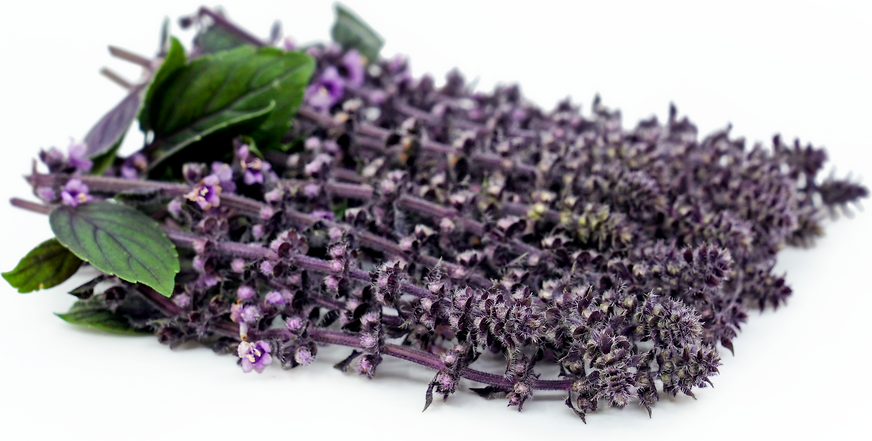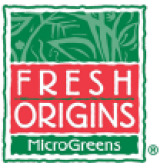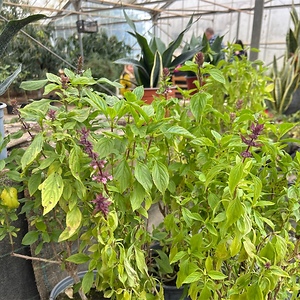


Basil Blossoms
Estimated Inventory, 50 ct : 9.00
This item was last sold on : 07/24/25
| Fresh Origins | Homepage |
Description/Taste
Basil Blossoms are long and slender, measuring approximately 15 to 18 centimeters in length, and are comprised of small delicate flowers attached to thin stems that range in color from bright green to dark purple, depending on the variety. The stems feature 2 to 4 ovate leaves that also range in color from bright green to dark green with deep purple veining, to purple. Basil Blossoms are comprised of 4 small, scalloped petals that range in color from white to a pale purple to a deep plum and feature delicate stamens extending from a round center. The scent of Basil Blossoms is sweet, floral, and warm, with notes of anise and clove. They feature a bold flavor with spicy-sweet notes of camphor, anise, and black licorice.
Seasons/Availability
Basil Blossoms are available year-round with a peak season in late summer.
Current Facts
Basil blossoms bloom from the long, bolted stems of basil plants, botanically classified as Ocimum basilicum. This herbaceous shrub is a member of the lamiaceae family and is related to a variety of common herbs including mint, rosemary, sage, and lavender. The color of basil blossoms varies depending on the type of basil, with Italian cultivars blooming white, and Thai, opal, and African blue cultivars producing dark purple and lavender flowers. Basil plants thrive in the summer heat and will begin to blossom mid to late summer. If left to develop, the flowers will grow to about 18 centimeters and open to reveal small blooms featuring 4 to 6 petals. Their heady aroma will attract a variety of pollinators, creating a beneficial environment for surrounding plants. Basil blossoms can be harvested at any stage and used as a garnish on savory and sweet dishes and within cocktails. Basil blossoms are also used in perfumes, soaps, and shampoos. Removing blossoms from basil plants early will increase the lifespan of the basil plant and help to ensure the newer leaves remain sweet.
Nutritional Value
The nutritional value of Basil blossoms has not been studied; however basil leaves are known to be high in vitamin K, a nutrient that is known to assist in blood clotting and bone health. The plant contains moderate levels of vitamin A to support tissue production, and vitamin C to support the immune system. The herb is also a good source for iron which helps build protein hemoglobin to transport oxygen through the blood.
Applications
Basil Blossoms are best suited for fresh applications as their delicate texture cannot withstand high heat preparations. Their robust sweet anise flavor lends itself to both savory and sweet applications. The blossoms can be used whole as a garnish, or the individual white and lavender-colored flowers can be separated from the stem. The flavorful blossoms can be sprinkled over pasta and grain dishes, or they can be added to fruit salads featuring strawberries and peaches. The flowers can be rolled into fresh pastas, folded into softened butter, or pressed into sugar cookies and soft cheeses. Basil blossoms can be added to olive oils and vinegars to impart flavor, or they can be steeped in simple syrup to flavor drinks and desserts. The showy blossoms can be used to decorate cakes, cupcakes, lemon bread, puddings, ice creams, and panna cotta, or they can be added to cocktails featuring gin, vodka, or sparkling wine. Basil blossoms pair well with spring and summer vegetables like squash, radishes, bell peppers, and tomatoes, aromatics such as onion, garlic, and leeks, and fruits like strawberries, watermelon, peaches, and lemons. The aromatic flowers can also be paired with nuts like walnuts, pine nuts, and pistachios, or with a variety of soft and hard cheeses including brie, goat, farmers, parmesan, and asiago. Basil blossoms should be refrigerated and will last up to 7 days when stored in an air-tight container with a paper towel to absorb access moisture.
Ethnic/Cultural Info
The basil pictured above was grown by Fresh Origins farm and has coloring similar to the African blue basil variety. African Blue Basil was discovered in 1983 in Athens, Ohio. The plant was found by Peter Borchard, the owner of Companion Plants, growing between a Camphor basil plant and Opal Basil plant. Borchard noticed the plants’ unique purple veined coloring and aromatic scent and decided to propagate the new variety to sell at his store. His first attempt revealed that the plant was sterile and would not produce seeds. This required him to propagate using clippings and to sell the variety as a potted plant as opposed to seed packs. African Blue Basil is a prolific bloomer, shooting up dark purple and lavender blossoms year-round in warmer climates. This has led to the plant commonly being planted as an ornamental; however, their fully edible flowers have a sweet anise flavor and fragrance that’s perfect for use as a garnish on sweet and savory dishes and in cocktails and lemonades. Fresh Origins, located in San Marcos, California, utilizes the warm southern California sun to harvest and sell Basil blossoms year-round. This product has become a favorite of local chefs and mixologists and can be found on menus in San Diego year-round.
Geography/History
Basil is believed to be native to India, where holy basil has been used in ayurvedic practice for over 5,000 years. The herb spread along trade routes into Asia, where it quickly naturalized and became a common culinary herb in many different cuisines. The herb also spread west to Africa where it was used in Ancient Egypt for medicinal and ritualistic practices. Basil reached the Mediterranean by 350 B.C. and was mainly for folkloric purposes until after the 14th century. The herb became a favored greenhouse herb in Great Britain during the 16th century. The English brought the herb to North America where it flourished in the temperate and sub-tropical climates of the region. Today Basil and Basil blossoms can be found growing outdoors in the world’s temperate, sub-tropical, and tropical regions. Basil blossoms can be found at farmers markets and specialty stores during the summer in temperate regions and year-round in some sub-tropical and tropical regions.
Featured Restaurants
Restaurants currently purchasing this product as an ingredient for their menu.
| Blue Water Estate Services | Rancho Santa Fe CA | 858-720-9831 |
| Venissimo Cheese Del Mar | Del Mar CA | 858-847-9616 |
| Seneca | San Diego CA | 619-588-2411 |
| Kettner Exchange Bar | San Diego CA | 909-915-9877 |
| Seneca Bar | San Diego CA | 619-588-2411 |
| Callie | San Diego CA | 619-947-9036 |
| Herb & Wood Bar | San Diego CA | 619-955-8495 |
| El Sueno (Bar) | San Diego CA | 619-972-6286 |
| Kingfisher | San Diego CA | 619-861-8074 |
| Mothership | San Diego CA | 858-342-3609 |
| Paradisaea Restaurant | La Jolla CA | 732-915-6669 |
| Manchester Grand Hyatt San Diego | San Diego CA | 619-232-1234 |
| Vulture / Dreamboat | San Diego CA | 858-342-3609 |
| The Tavern | Coronado CA | 602-628-5890 |
| Pacific Yacht Agents | Los Angeles CA | 808-214-0970 |
| Understory | San Diego CA | 516-507-0101 |
| Bridges at Rancho Santa Fe | Rancho Santa Fe CA | 858-759-6063 |
Recipe Ideas
Recipes that include Basil Blossoms. One
| Salt Vanilla |
|
Korean Melon with Apple and Ginger |




 Learn More...
Learn More...




